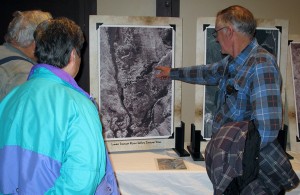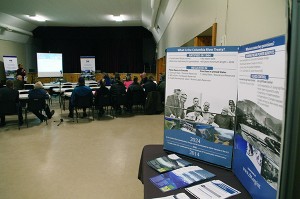Home »

Local governments submit recommendations on treaty
Local governments have submitted their recommendations regarding the future of the Columbia River Treaty (Treaty) to the provincial and federal governments.
 Ensuring a voice for Columbia Basin residents in future Treaty discussions, reducing impacts from Treaty-related dams, enhancing ecosystem function, and sharing equitably in any benefits flowing from the 1964 Treaty are among the key recommendations.
Ensuring a voice for Columbia Basin residents in future Treaty discussions, reducing impacts from Treaty-related dams, enhancing ecosystem function, and sharing equitably in any benefits flowing from the 1964 Treaty are among the key recommendations.
“Basin residents were clear about their issues and concerns related to the future of the Columbia River Treaty and we’ve worked together to find practical solutions that address a range of Treaty-related issues from salmon restoration, to increasing input from Basin residents in dam operations,” says Deb Kozak, Chair of the Columbia River Treaty Local Governments’ Committee. “Our recommendations are with government now and we expect that they will be incorporated into any decisions about the future of the Treaty.”
Both B.C. and the U.S. are in the process of developing recommendations on the future of the Treaty because 2014 is the earliest opportunity that either country can give notice to terminate substantial portions of the Treaty, which would take effect in 10 years.
“Residents want local government and First Nations’ input into any future discussions about the Treaty,” says Kozak. “And they want the Provincial Treaty Review Team to continue assessing alternative scenarios for Treaty dams and reservoirs that would improve ecosystem function and other values. Residents in BC especially want to understand what it would mean for this region if the Columbia River was managed to meet the U.S. request for increased Columbia River flows in spring and summer.”

More than 235 people attended recent workshops hosted by the Provincial Treaty Review Team and the CRT Local Governments’ Committee in November, and more than 100 people provided written input on the recommendations drafted by the committee. Residents generally support the committee’s 12 recommendations directly related to the Treaty, and its five recommendations to address domestic Treaty- related issues. They also suggested refinements to the draft recommendations, which the committee has reviewed to prepare their current recommendations.
The Committee’s recommendations are available from the Committee’s webpage (www.akblg.ca/content/columbia-river-treaty). They address the following international Treaty issues:
– Local government status in international discussions;
– continued engagement with Basin residents;
– assessing benefits and impacts;
– reducing negative impacts to the Basin;
– equitable benefit-sharing;
– expanding the focus of the Treaty to include ecosystems and other interests;
– flood risk management;
 – Canadian input to Libby Dam operations;
– Canadian input to Libby Dam operations;
– power generation;
– continuing Treaty rights to water use in B.C.;
– integrating climate change; and
– pursuing salmon restoration. Recommendations regarding regional or so-called domestic issues address:
– mitigation and/or compensation for negative impacts in the B.C. portion of the Basin;
– community economic development;
– meaningful ongoing engagement of Basin residents;
– restoration and conservation of fish and wildlife in the East Kootenay-Koocanusa;
– a water management process for the Kootenay River;
– full implementation of the Columbia River and Duncan Dam Water Use Plans; and
– The Columbia Fish and Wildlife Compensation Program. A summary of the feedback received on the Committee’s draft recommendations and an updated Summary of Dam and Reservoir Issues will be posted on the Committee’s webpage in early January.
Background
The Columbia River Treaty is an international agreement between Canada and the United States to coordinate flood control and optimize hydroelectric power generation on both sides of the border.
Under the 1964 Treaty, three dams were constructed in Canada, including Mica Dam, Duncan Dam and Hugh Keenleyside Dam. A fourth dam, Libby, was constructed in Montana. Its reservoir, the Koocanusa, extends 67 kilometres into Canada.
Since its ratification in 1964, the CRT has influenced the management of the Columbia and Kootenay River systems in both Canada and the United States. Residents in the Columbia Basin, on both sides of the border, will be directly affected by any decision related to the future of the CRT and will shape trans-boundary water management across the entire Columbia Basin for decades to come.
The CRT has no official expiry date, but has a minimum length of 60 years, which will be met in September 2024. Either Canada or the United States can terminate many of the provisions of the agreement effective any time after September 2024, provided written notice is filed at least 10 years’ in advance (2014). While no decision has been made by either Canada or the United States on the future of the current Treaty, given the importance of the issues, and the approaching date of 2014, both countries are now conducting studies and exploring future options for the CRT.
The CRT Local Governments’ Committee (the Committee), with support from Columbia Basin Trust (CBT), is working with, and on behalf of local governments through appointed representatives from the four regional districts in the Basin, the Village of Valemount and the Association of Kootenay Boundary Local Governments (AKBLG). The committee is working together to bring regional views, values and interests with respect to the CRT to provincial and federal agencies. With the support of Columbia Basin Trust, the committee is helping Basin residents and local governments engage in decisions about the future of the CRT.
Lead image: Mica Dam construction began after the ratification of the Columbia River Treaty on September 16, 1964. Highway 23 from Revelstoke, BC to the Mica Creek Dam site (93 miles [149 km] north of Revelstoke) was paved in 1968. The Mica Dam became operational on March 29, 1973. (From: http://www.flickr.com/photos/45379817@N08/7611656112/)
Association of Kootenay Boundary Local Governments







